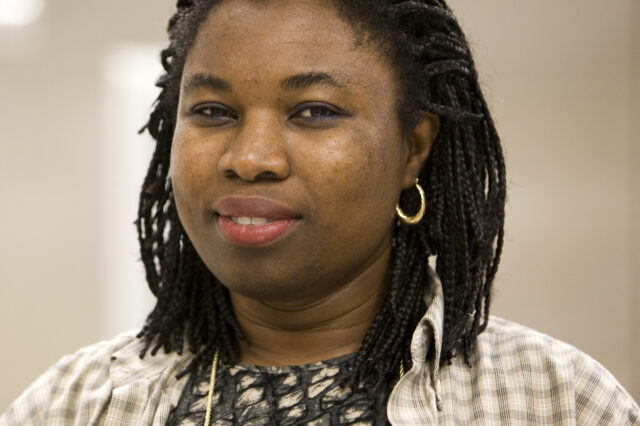The sweet science: Viruses switch grip to gain upper hand

Mavis Agbandje-McKenna, a structural biologist at the University of Florida’s McKnight Brain Institute, studies how viruses infect cells. She has found that b y changing which carbohydrates they attach to, viruses are able to infect cells more efficiently — a finding that may prove valuable to scientists seeking ways to fight cancer or brain diseases. (Photo by Sarah Kiewel/University of Florida)
Carbohydrates can be attractive, especially when they come packaged in candy bars or never-ending bowls of pasta.
Even viruses - those bits of occasionally harmful genetic material enclosed in shells of protein and fat - crave carbs. Except viruses aren't seeking a taste treat. They want to latch onto the carbohydrates that protrude from the surface of our cells and mount an invasion.
By changing which carbohydrates they attach to, viruses are able to infect cells more efficiently - a finding that may prove valuable to scientists seeking ways to fight cancer or brain diseases, say University of Florida researchers writing in the current Journal of Biological Chemistry. The discovery also helps explain how flu and other viruses are able to stay a step ahead of our body's own versatile immune system.
"If you think about the flu virus, a few simple amino acid changes can be the difference between a virus your body can defend against and one that will make you sick," said Mavis Agbandje-McKenna, Ph.D., an associate professor of biochemistry and molecular biology in the UF College of Medicine and senior author of the paper. "It seems structural juxtapositions of amino acids play a role in determining how viruses recognize cells and whether the viruses are harmful."
The idea that proteins on a virus' outer shell mutate to get a more lethal grip on a cell's sugary coat of carbohydrates, or glycans, became apparent when UF scientists studied the Minute Virus of Mice, or MVM.
One strain of the virus, MVMp, is harmless and causes no ill effects, even in mice without a functioning immune system. However, a different version of the virus, MVMi, can be fatal to these mice. Both viruses resemble miniature, 20 -sided soccer balls, and between them their outer protein shells differ by only 14 out of more than 500 amino acids.
But a few years ago, the normally mild MVMp virus mutated slightly, suddenly becoming harmful to the defenseless mice.
"One or two changes in amino acids made the difference between a virus that kills and one that does not kill mice," said Agbandje-McKenna, who is associated with both UF's McKnight Brain Institute and the UF Genetic Institute. "We wanted to know how such a slight change could make this virus become lethal."
Working with the Consortium for Functional Glycomics, an international team of more than 230 scientists under the National Institute of General Medical Sciences, UF researchers became the first to use a new technique called a glycan array to study how a whole, intact virus interacts with carbohydrates.
Scientists exposed 189 glycans mounted on a 3 -by- 5 -inch plastic plate to dangerous MVMi, harmless MVMp and three potentially dangerous, mutant strains of MVMp.
Scientists found MVMp proteins stuck to the same three glycans on the plate. However, one of the mutant MVMp viruses also bound to an additional glycan - one associated with the more dangerous MVMi strain.
"A single amino-acid change in the virus' protein shell changes how it can grip the cell, making it more deadly," she said. "Actually, the affinity is reduced, so the more deadly strain of the virus actually does not bind as tightly. We're not sure why, but it may be because it can more easily let go and get into the cell to cause disease. It's not giving the body the time to mount an immune response."
Understanding how viruses adapt to different hosts and different tissues could be useful for developing gene therapies, which involve introducing specially engineered genes into a patient's cells via apparently harmless viruses. In cancer treatment, the new genes might be intended to prompt the body's natural defenses or actually attack the cancer cells themselves.
In terms of medical treatments, the finding helps explain why a virus would be able to home in on a cancer or brain cell - by recognizing sugars on the cell's surface, according to Hyun-Joo Nam, Ph.D., an assistant scientist in department of biochemistry and molecular biology and the paper's first author.
"Scientists want to use viruses they know to be nonpathogenic as vehicles for either gene and cancer therapies, and they also want to know how viruses target cancer and other differentiated cells," said Peter Tattersall, Ph.D., a professor of laboratory medicine and genetics at Yale University who was not involved in the research. "The most likely medical significance of this finding is for fine-tuning viruses and vectors to target cancer and other differentiated cell types. This is a major field that is advancing rapidly."